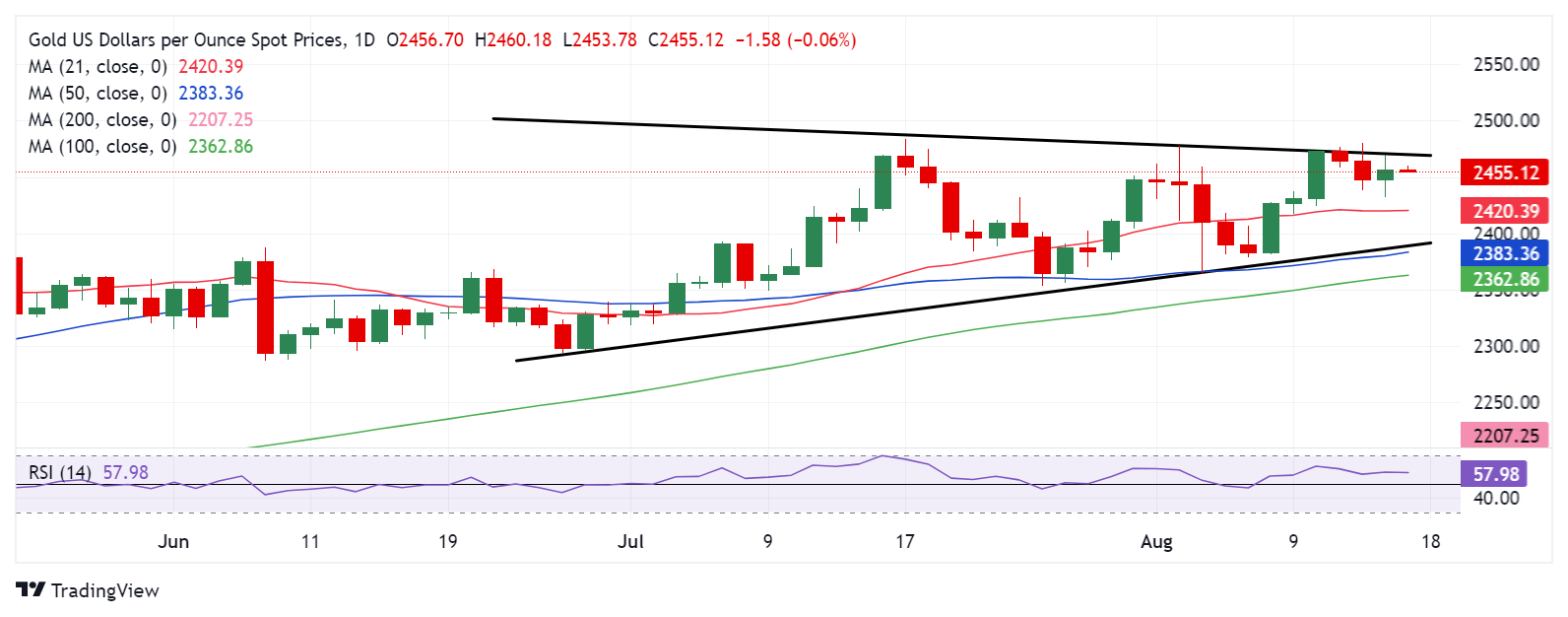- Gold price stays supported above $2,450, as buyers refuse to give up.
- The US Dollar and Treasury bond yields take a breather after Thursday’s solid rebound.
- US economic data eased recessionary fears, lifting risk sentiment and the US Dollar.
- Gold price needs a weekly close above $2,470 to confirm a symmetrical triangle breakout.
Gold price clings to the previous recovery gains while defending the $2,450 psychological level early Friday, as optimism extends into Asia following strong US Retail Sales and Jobless Claims data released on Thursday.
Gold price eyes US sentiment data for fresh push higher
Gold price sustained its rebound even though strong US consumer spending and jobs data provided the latest shot in the arm for the upbeat risk tone, especially after a benign inflation report earlier this week, pouring cold water on big interest-rate cuts by the US Federal Reserve (Fed) in September. Markets are now pricing in just a 25% chance of a 50-basis point (bps) cut from the Fed next month, down from 55% a week ago, according to the CME Group’s FedWatch tool.
Retail Sales in the US climbed 1% on the month, according to numbers that are adjusted for seasonality but not inflation, beating the expectations of a 0.3% increase by a wide margin. Meanwhile, Initial Jobless claims for the week ended Aug. 10 came in at 227,000, a drop of 7,000 from the previous week and lower than the estimate for 235,000.
Encouraging US economic statistics alleviated concerns over a potential US recession, offering a fresh life to the US Dollar alongside the US Treasury bond yields, as risk-on sentiment killed the demand for the safe-haven US government bonds.
Gold price upside remained limited but it stood resilient, in the face of resurgent US Dollar demand, as looming Middle East geopolitical tensions continued to underpin the sentiment around the traditional safe-haven.
In Friday’s Asian trading so far, the US Dollar is consolidating the previous upswing while the US Treasury bond yields are holding steady, keeping Gold price slightly on the back foot, as traders look to more macro news from the US for the next directional impetus.
The US Michigan Consumer Sentiment and Inflation Expectations data will be released later in the American session on Friday. Meanwhile, a speech from Chicago Fed President Austan Goolsbee will be also closely scrutinized for fresh hints on the size and the timings of the Fed’s next interest-rate cut.
Gold traders could also resort to position readjustment heading into next week’s highly-anticipated Fed’s Jackson Hole Symposium. The end-of-the-week flows will also play a crucial part in the Gold price action later in the day.
Also of note will remain the simmering tensions between Israel and Iran, with the Israeli Defense Ministry having reportedly imposed sanctions on 18 oil tankers transporting Iranian oil to cut down Iran's vital fuel sale revenues.
This comes after Iran's Supreme Leader Ayatollah Ali Khamenei issued a warning on Thursday against any form of retreat or compromise, invoking the concept of "divine wrath".
Gold price technical analysis: Daily chart
The short-term technical outlook for Gold price remains more or less the same, as the upper boundary of a symmetrical triangle formation near $2,470 continues to act as a tough nut to crack for Gold buyers.
Buyers await daily closing above that level to confirm a triangle breakout. The 14-day Relative Strength Index (RSI) holds firm above the 50 level, adding credence to the bullish potential in Gold price.
The next topside target is seen at the all-time high of $2,484, above which the $2,500 mark will be put to the test.
On the flip side, any pullback in Gold price could challenge the bullish commitments at Thursday’s low of $2,432, below which the 21-day Simple Moving Average (SMA) support at $2,420 will be threatened.
Should the selling momentum intensify on a sustained break of the 21-day SMA,, the next relevant support is seen at $2,380, where the lower boundary of the triangle and the 50-day SMA converge.
Gold FAQs
Gold has played a key role in human’s history as it has been widely used as a store of value and medium of exchange. Currently, apart from its shine and usage for jewelry, the precious metal is widely seen as a safe-haven asset, meaning that it is considered a good investment during turbulent times. Gold is also widely seen as a hedge against inflation and against depreciating currencies as it doesn’t rely on any specific issuer or government.
Central banks are the biggest Gold holders. In their aim to support their currencies in turbulent times, central banks tend to diversify their reserves and buy Gold to improve the perceived strength of the economy and the currency. High Gold reserves can be a source of trust for a country’s solvency. Central banks added 1,136 tonnes of Gold worth around $70 billion to their reserves in 2022, according to data from the World Gold Council. This is the highest yearly purchase since records began. Central banks from emerging economies such as China, India and Turkey are quickly increasing their Gold reserves.
Gold has an inverse correlation with the US Dollar and US Treasuries, which are both major reserve and safe-haven assets. When the Dollar depreciates, Gold tends to rise, enabling investors and central banks to diversify their assets in turbulent times. Gold is also inversely correlated with risk assets. A rally in the stock market tends to weaken Gold price, while sell-offs in riskier markets tend to favor the precious metal.
The price can move due to a wide range of factors. Geopolitical instability or fears of a deep recession can quickly make Gold price escalate due to its safe-haven status. As a yield-less asset, Gold tends to rise with lower interest rates, while higher cost of money usually weighs down on the yellow metal. Still, most moves depend on how the US Dollar (USD) behaves as the asset is priced in dollars (XAU/USD). A strong Dollar tends to keep the price of Gold controlled, whereas a weaker Dollar is likely to push Gold prices up.
Information on these pages contains forward-looking statements that involve risks and uncertainties. Markets and instruments profiled on this page are for informational purposes only and should not in any way come across as a recommendation to buy or sell in these assets. You should do your own thorough research before making any investment decisions. FXStreet does not in any way guarantee that this information is free from mistakes, errors, or material misstatements. It also does not guarantee that this information is of a timely nature. Investing in Open Markets involves a great deal of risk, including the loss of all or a portion of your investment, as well as emotional distress. All risks, losses and costs associated with investing, including total loss of principal, are your responsibility. The views and opinions expressed in this article are those of the authors and do not necessarily reflect the official policy or position of FXStreet nor its advertisers. The author will not be held responsible for information that is found at the end of links posted on this page.
If not otherwise explicitly mentioned in the body of the article, at the time of writing, the author has no position in any stock mentioned in this article and no business relationship with any company mentioned. The author has not received compensation for writing this article, other than from FXStreet.
FXStreet and the author do not provide personalized recommendations. The author makes no representations as to the accuracy, completeness, or suitability of this information. FXStreet and the author will not be liable for any errors, omissions or any losses, injuries or damages arising from this information and its display or use. Errors and omissions excepted.
The author and FXStreet are not registered investment advisors and nothing in this article is intended to be investment advice.
Recommended Content
Editors’ Picks

EUR/USD turns negative below 1.0900, Dollar regains traction
EUR/USD now comes under fresh downside pressure following an acceptable pick-up in the Greenback, slipping back to the area below 1.0900 the figure in response to disheartening headlines from China regarding US tariffs

GBP/USD trims losses and recedes to 1.2750
GBP/USD is now giving away part of the initial move to the boundaries of the 1.2800 region, retreating towards the 1.2750 zone amid decent gains and despite a modest recovery attempt in the US Dollar.

Gold rebounds toward $3,020 as trade war tensions remain high
Gold gathers bullish momentum and climbs toward $3,020 after suffering heavy losses on Monday. Improving market mood and rising US Treasury bond yields cap XAU/USD's upside, while a lack of headlines hinting at easing trade tensions supports the pair.

Who is Satoshi? Crypto lawyer sues DHS to reveal Satoshi Nakamoto's identity
James Murphy, a cryptocurrency lawyer popularly known to his followers on X as "MetalLawMan," has filed a lawsuit in a D.C. District Court against the Department of Homeland Security (DHS). He intends to uncover the real face or faces behind Satoshi Nakamoto, the pseudonymous creator of Bitcoin.

The Fed is looking at a hefty price level
We are still in thrall to tariffs, the faux-macro “data” driving markets. The WSJ editorial board advised other countries to take their tariffs to zero so that Trump’s “reciprocal” tariffs will have to be zero, too. Cute, but no cigar.

The Best brokers to trade EUR/USD
SPONSORED Discover the top brokers for trading EUR/USD in 2025. Our list features brokers with competitive spreads, fast execution, and powerful platforms. Whether you're a beginner or an expert, find the right partner to navigate the dynamic Forex market.
